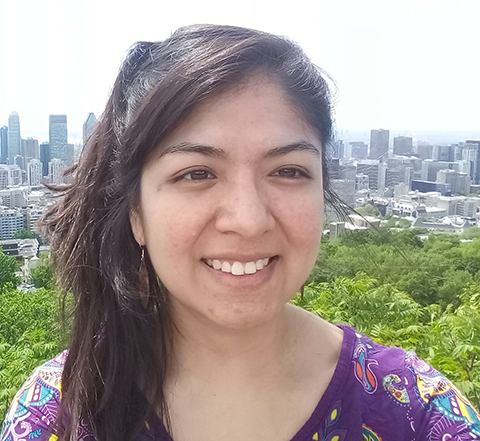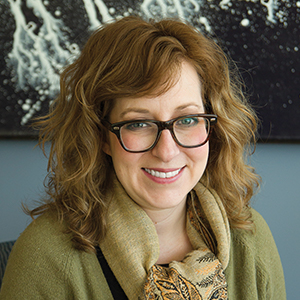Meet Josseline Ramos–Figueroa
Josseline Ramos–Figueroa, a Ph.D. student at the University of Saskatchewan, will be one of two official tweeters for the American Society for Biochemistry and Molecular Biology's annual meeting, which will be held virtually in conjunction with Experimental Biology later this month. ASBMB Today talked to her about her background, experience with science communication and expectations for the meeting. The interview has been edited for style.
Tell me a bit about your educational journey.
I grew up in the busiest city of Peru, Lima. I got my undergraduate degree in chemistry from Universidad Nacional de Ingenieria, a science and engineering public university. I remember not being super good at chemistry at the beginning, to be honest. But I fell in love with the field as I studied more of it.

I enjoyed the experimental part of it but also the theory behind it. I remember enjoying making sense of my experimental results or observations using theoretical concepts.
What I enjoyed the most was when I made the connection of chemistry with the biological world. Being able to find meaning about the intricacies of biology through chemistry was absolutely fascinating to me. So, I decided to apply to a graduate program to get research experience but also to learn about enzymes, which are key players in biology.
Tell me a bit about your research.
At the Palmer lab at the University of Saskatchewan, I studied enzymes related to myo-inositol metabolism. This molecule is present in all domains of life, and its metabolic pathways are potential targets against pathogens that depend on myo-inositol for survival.
This important molecule is made in two steps from glucose 6-phosphate. The first step was relevant to my studies, as I studied the enzyme catalyzing this transformation, myo-inositol 1-phosphate synthase.
I investigated how analogs that closely resemble its substrate, G6P, inhibit its catalytic reaction. A simple way to do this is by making phosphonate analogs where the C-O-P bridge in the polar phosphate handle of G6P is replaced with a C-CH2-P that can also be functionalized by the addition of F.
Another part of my project was to use the enzymes involved to make myo-inositol in the cell in a scale-up reaction to biocatalytically make 13C-isotopically labeled myo-inositol. These singly labeled probes are useful to investigate enzymatic transformations of myo-inositol. So, I used these labels to determine the products of a bacterial enzyme that oxidizes myo-inositol in its catabolic pathway.
What kind of career do you want to have?
It is complicated. I don't have anything set right now.
Ideally, I would like to further my research training by learning state-of-the-art approaches and techniques. Some of the areas I am interested in are studying other key biological players such as RNA, harnessing enzyme potential to catalyze non-natural reactions, and elucidating existing natural enzyme activities but with novel reactivities and products. So, a postdoc in academia is what I have in mind.
However, with my experience in protein biochemistry and synthetic organic chemistry, I also have in mind industry positions.
Lastly, I am also open to less conventional career paths that I would still find enjoyable. Throughout my studies, I have had the opportunity to get involved in news science writing and communication positions.
You’ve been building up your science writing portfolio for a while now. How did that come about, and do you have any advice for those who want to do the same?
It started in the most unconventional way possible. I wasn't expecting it, and I don't recall noticing anything that would bring me to science writing. But it was during the quarantine time that it came to my attention.
I saw ads for the science communication course by ASBMB and the science training module by Massive Science. I signed up for the two of them, but that was too ambitious. So, I only ended up finishing the MS module. I am planning to register for the next scicomm course by ASBMB though.
I found out that I love writing stories from scientific articles, finding angles, and thinking about what would be interesting to the public.
My advice would be to read as much as you can of news science stories. It makes it easier to understand the concepts and the ideas behind science writing. Oh! And for sure follow scicomm writing handles on Twitter for free online workshops or panels to learn from and feel part of the community.
What else are you passionate about? What do you do in your spare time?
I try to keep active, and I really enjoy going for runs, spinning classes or finding new workout routines that can help me run faster. I am passionate about eating healthy as well, so I try new recipes every time I can. Besides that, watching movies and TV shows, listening to music, drawing, chatting with friends and family.
Anything else you’d like to share?
Yes, thank you for giving me the opportunity to participate in the ASBMB annual meeting!
Enjoy reading ASBMB Today?
Become a member to receive the print edition four times a year and the digital edition monthly.
Learn moreGet the latest from ASBMB Today
Enter your email address, and we’ll send you a weekly email with recent articles, interviews and more.
Latest in People
People highlights or most popular articles

Meet the editor-in-chief of ASBMB’s new journal, IBMB
Benjamin Garcia will head ASBMB’s new journal, Insights in Biochemistry and Molecular Biology, which will launch in early 2026.

Exploring the link between lipids and longevity
Meng Wang will present her work on metabolism and aging at the ASBMB Annual Meeting, March 7-10, just outside of Washington, D.C.

Defining a ‘crucial gatekeeper’ of lipid metabolism
George Carman receives the Herbert Tabor Research Award at the ASBMB Annual Meeting, March 7–10, just outside of Washington, D.C.

Nuñez receives Vallee Scholar Award
He will receive $400,000 to support his research.

Mydy named Purdue assistant professor
Her lab will focus on protein structure and function, enzyme mechanisms and plant natural product biosynthesis, working to characterize and engineer plant natural products for therapeutic and agricultural applications.

In memoriam: Michael J. Chamberlin
He discovered RNA polymerase and was an ASBMB member for nearly 60 years.

